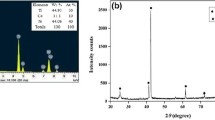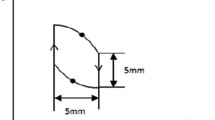Abstract
TiNiCo shape memory alloy is most popular shape memory alloy for biomedical applications due to their outstanding properties such as shape memory effect, pseudoelasticity and transformation temperature. Machining of such kind of alloys is very difficult through conventional machining process is very difficult because they may affect their internal properties of these alloys. However conventional machining processes give poor surface quality during the machining hence non-conventional machining processes such as (wire electro discharge machining, water jet machining and electro discharge machining etc.) are more suitable for machining of such kind of alloy. From the literature it has been found that Wire electro discharge machining (WEDM) is more suitable non-conventional machining process for such kind of alloy. Present study exhibits the effects WEDM characteristics of Ti50Ni45Co5 shape memory alloy. L-9 orthogonal array has been created by using Taguchi as a design method for machining of selected alloy and machined surface characterization has been carried out at the optimized process parameters with respect to microstructures, surface topography, microhardness, XRD analysis and residual stresses. To find the optimum setting of the input process parameters a couple of optimization techniques are used, namely principal component analysis (PCA) and Gray relational analysis (GRA) technique. 125μs pulse on time (Ton), 35μs pulse off time (Toff) and 40V servo voltage (SV) were found as an optimal setting for the higher material removal rate (MRR) with better surface roughness (SR) in the present study. Moreover, characterization of the machined surface is performed with respect to microstructures, surface topography, microhardness analysis, XRD and residual stresses. Harder surface observed near the cutting edge and TiNio3 Tio2 and CuZn were noticed on the surface of machined component through XRD analysis. However, compressive residual stress has been noticed on the machined surface during WEDM process.
Similar content being viewed by others
References
Nolan M, Tofail SAM (2010) Density functional theory simulation of titanium migration and reaction with oxygen in the early stages of oxidation of equiatomic NiTi alloy. Biomaterials 31:3439–3448. https://doi.org/10.1016/j.biomaterials.2010.01.060
Park C, Kim S, Kim HE, Jang TS (2016) Mechanically stable tantalum coating on a nano-roughened NiTi stent for enhanced radiopacity and biocompatibility. Surf Coatings Technol 305:139–145. https://doi.org/10.1016/j.surfcoat.2016.08.014
Cicek H, Efeoglu I (2016) Fatigue and adhesion properties of martensite and austenite phases of TiNi shape memory thin films deposited by magnetron sputtering. Surf Coatings Technol 308:174–181. https://doi.org/10.1016/j.surfcoat.2016.07.101
Zheng YF, Zhang BB, Wang BL, Wang YB, Li L, Yang QB, Cui LS (2011) Introduction of antibacterial function into biomedical TiNi shape memory alloy by the addition of element Ag. Acta Biomater 7:2758–2767. https://doi.org/10.1016/j.actbio.2011.02.010
Elahinia MH, Hashemi M, Tabesh M, Bhaduri SB (2012) Manufacturing and processing of NiTi implants: A review. Prog Mater Sci 57:911–946. https://doi.org/10.1016/j.pmatsci.2011.11.001
Lekston Z, Stroz D, Drusik-Pawlowska MJ (2012) Preparation and characterization of nitinol bone staples for cranio-maxillofacial surgery. J Mater Eng Perform 21:2650–2656. https://doi.org/10.1007/s11665-012-0372-3
Wever DJ, Veldhuizen AG, Sanders MM, Schakenraad JM, Van Horn JR (1997) Cytotoxic, allergic and genotoxic activity of a nickel-titanium alloy. Biomaterials 18:1115–1120. https://doi.org/10.1016/S0142-9612(97)00041-0
Kumar A, Kumar V, Kumar J (2013) Multi-response optimization of process parameters based on response surface methodology for pure titanium using WEDM process. Int J Adv Manuf Technol 68:2645–2668. https://doi.org/10.1007/s00170-013-4861-9
Sun Y, Gong Y, Liu Y, Cai M, Ma X, Li P (2017) ScienceDirect experimental investigation on effects of machining parameters on the performance of Ti-6Al-4V micro rotary parts fabricated by LS-WEDT. Arch Civ Mech Eng 18:385–400. https://doi.org/10.1016/j.acme.2017.09.006
Sun Y, Gong Y, Liu Y, Li Q, Zhou Y (2017) Experimental study on surface characteristics and improvement of microelectrode machined by low speed wire electrical discharge turning. Arch Civ Mech Eng 17:964–977. https://doi.org/10.1016/j.acme.2017.02.004
Liu G, Huang C, Zou B, Wang X, Liu Z (2016) Surface integrity and fatigue performance of 17-4PH stainless steel after cutting operations. Surf Coatings Technol 307:182–189. https://doi.org/10.1016/j.surfcoat.2016.08.086
Pukasiewicz AGM, de Boer HE, Sucharski GB, Vaz RF, Procopiak LAJ (2017) The influence of HVOF spraying parameters on the microstructure, residual stress and cavitation resistance of FeMnCrSi coatings. Surf Coatings Technol 327:158–166. https://doi.org/10.1016/j.surfcoat.2017.07.073
Mello MG, Taipina MO, Rabelo G, Cremasco A, Caram R (2017) Production and characterization of TiO 2 nanotubes on Ti-Nb-Mo-Sn system for biomedical applications. Surf Coatings Technol 326:126–133. https://doi.org/10.1016/j.surfcoat.2017.07.027
Mordyuk BN, Prokopenko GI, Grinkevych KE, Piskun NA, Popova TV (2017) Effects of ultrasonic impact treatment combined with the electric discharge surface alloying by molybdenum on the surface related properties of low-carbon steel G21Mn5. Surf Coatings Technol 309:969–979. https://doi.org/10.1016/j.surfcoat.2016.10.050
Javadi S, Ghoranneviss M, Rawat RS, Salar Elahi A (2017) Topographical, structural and hardness changes in surface layer of stainless steel-AISI 304 irradiated by fusion-relevant high energy deuterium ions and neutrons in a low energy plasma focus device. Surf Coatings Technol 313:73–81. https://doi.org/10.1016/j.surfcoat.2017.01.054
Zhu L, Guan Y, Wang Y, **e Z, Lin J, Zhai J (2017) Influence of process parameters of ultrasonic shot peening on surface roughness and hydrophilicity of pure titanium. Surf Coatings Technol 317:38–53. https://doi.org/10.1016/j.surfcoat.2017.03.044
Prakash C, Uddin M S (2017) Surface modification of β-phase Ti implant by hydroaxyapatite mixed electric discharge machining to enhance the corrosion resistance and in-vitro bioactivity. Surf Coatings Technol 326:134–145. https://doi.org/10.1016/j.surfcoat.2017.07.040
Manjaiah M, Narendranath S, Basavarajappa S, Gaitonde VN (2015) Effect of electrode material in wire electro discharge machining characteristics of Ti50Ni50-xCux shape memory alloy. Precis Eng 41:68–77. https://doi.org/10.1016/j.precisioneng.2015.01.008
Soni H, Majhi SK (2013) Multi-response optimization of EDM using Grey-PCA approach, pp 1–5
Sivaprakasam P, Hariharan P, Gowri S (2013) Optimization of micro-WEDM process of aluminum matrix composite (A413-B4C): a response surface approach. Mater Manuf Process 28:1340–1347. https://doi.org/10.1080/10426914.2013.823502
Soni H, Sannayellappa N, Motagondanahalli Rangarasaiah R (2017) An experimental study of influence of wire electro discharge machining parameters on surface integrity of TiNiCo shape memory alloy. J Mater Res 32:1–9. https://doi.org/10.1557/jmr.2017.137
Pradhan MK (2013) Optimization of MRR, TWR and surface roughness of EDMed D2 steel using an integrated approach of RSM, GRA and entropy measutement method. In: 2013 Int. Conf. Energy Effic. Technol. Sustain. ICEETS, vol 2013, pp 865–869. https://doi.org/10.1109/ICEETS.2013.6533499
Sharma P, Chakradhar D, Narendranath S (2015) Evaluation of WEDM performance characteristics of Inconel 706 for turbine disk application. Mater Des 88:558–566. https://doi.org/10.1016/j.matdes.2015.09.036
Chalisgaonkar R, Kumar J (2016) Investigation of the machining parameters and integrity of the work and wire surfaces after finish cut WEDM of commercially pure titanium. J. Brazilian Soc Mech Sci Eng 38:883–911. https://doi.org/10.1007/s40430-015-0335-3
Choudhary R, Kumar H, Garg RK (2010) Analysis and evaluation of heat affected zones in electric discharge machining of EN-31 die steel. Indian J Eng Mater Sci 17:91–98
Kumar P, Singh PK, Kumar D, Prakash V, Hussain M, Das AK (2016) A novel application of micro-EDM process for the generation of nickel nanoparticles with different shapes. Mater Manuf Process 32:1–9. https://doi.org/10.1080/10426914.2016.1244832
Ekmekci B, Elkoca O, Erman Tekkaya A, Erden A (2005) Residual stress state and hardness depth in electric discharge machining: de-ionized water as dielectric liquid. Mach Sci Technol 9:39–61. https://doi.org/10.1081/MST-200051244
Newton TR, Melkote SN, Watkins TR, Trejo RM, Reister L (2009) Investigation of the effect of process parameters on the formation and characteristics of recast layer in wire-EDM of Inconel 718. Mater Sci Eng A 513–514:208–215. https://doi.org/10.1016/j.msea.2009.01.061
Srinivasa Rao P, Ramji K, Satyanarayana B (2016) Effect of wire EDM conditions on generation of residual stresses in machining of aluminum 2014 T6 alloy. Alexandria Eng J 55:1077–1084. https://doi.org/10.1016/j.aej.2016.03.014
Soo SL, Antar MT, Aspinwall DK, Sage C, Cuttell M, Perez R, Winn AJ (2013) The effect of wire electrical discharge machining on the fatigue life of Ti-6Al-2Sn-4Zr-6Mo aerospace alloy. Procedia CIRP 6:215–219. https://doi.org/10.1016/j.procir.2013.03.043
Acknowledgments
This work was supported by Department of Science and Technology (DST), Government of India, and bearing project reference no. SB/S3/MMER/0067/2013. The authors acknowledge Prof. I Samajhdar, Department of metallurgical engineering and materials, IIT Bombay for providing the facility to measure residual stresses.
Author information
Authors and Affiliations
Corresponding author
Rights and permissions
About this article
Cite this article
Soni, H., S, N. & M R, R. Experimental Investigation on Effects of Wire Electro Discharge Machining of Ti50Ni45Co5 Shape Memory Alloys. Silicon 10, 2483–2490 (2018). https://doi.org/10.1007/s12633-018-9780-9
Received:
Accepted:
Published:
Issue Date:
DOI: https://doi.org/10.1007/s12633-018-9780-9




